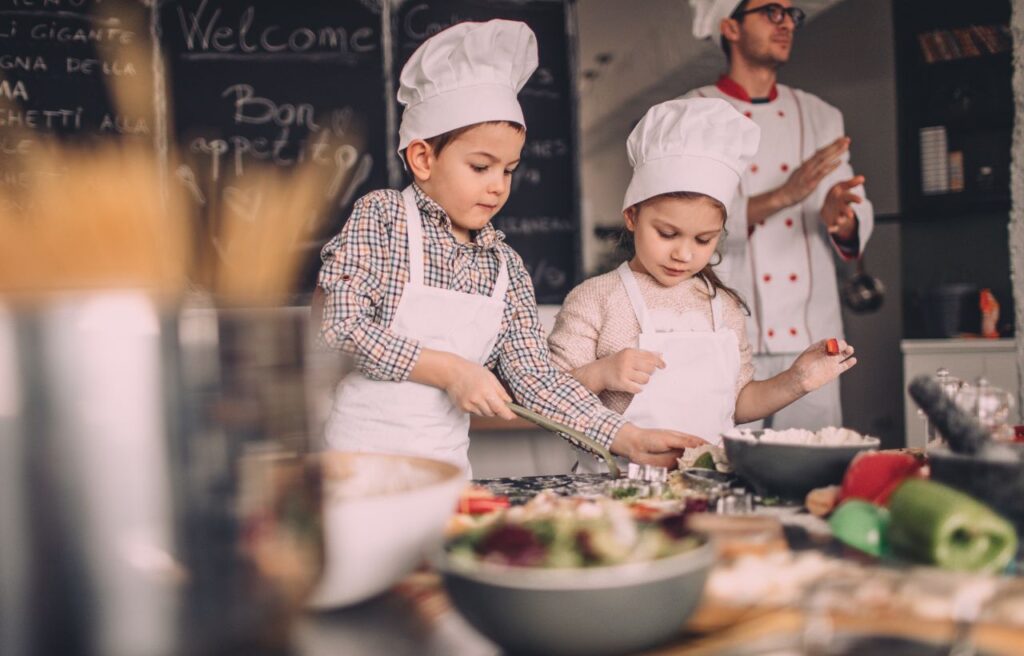Fostering a love of cooking in your child can provide lifelong benefits, such as healthy eating habits, creativity, and confidence in the kitchen. Here are some tips on how to instill in your child a love of cooking.
Table of Contents
Start Early and Keep It Age-Appropriate
Introduce your child to cooking at an early age, beginning with simple, age-appropriate tasks. As they grow, gradually increase their involvement in the kitchen. Here are some suggestions for age-appropriate activities:
- Toddlers: Stirring, washing fruits and vegetables, or tearing lettuce
- Preschoolers: Measuring ingredients, cracking eggs, or spreading condiments
- Elementary-age children: Chopping, mixing, or assembling meals
Make Cooking Fun and Engaging
Turn cooking into a fun and engaging activity by:
- Creating themed meals: Plan meals around holidays, favorite characters, or colors.
- Involving their interests: Choose recipes that align with your child’s hobbies or passions.
- Playing games: Create cooking-related games, such as a “mystery ingredient” challenge or a taste test.
- Turn Cooking into a Challenge : Transform cooking into a game or challenge by setting up friendly competitions or timed activities. For example, create a “mystery ingredient” challenge where children must incorporate a surprise ingredient into their dish or a “top chef” competition with a panel of family members as judges.
Use Colorful, Fun Kitchen Tools and Utensils
Invest in colorful, fun kitchen tools and utensils that appeal to children, such as measuring cups shaped like animals or brightly colored mixing bowls. These items can make the cooking process more visually appealing and enjoyable for young chefs.
Create Theme Nights or Special Occasions
Plan theme nights or special occasions that revolve around cooking, such as pizza night, taco night, or a DIY sushi party. These events can make cooking more enjoyable and provide a fun atmosphere for children to experiment with new recipes and ingredients.

Encourage Creativity and Experimentation
Encourage your child to explore their creativity in the kitchen by:
- Offering ingredient choices: Let them choose between different fruits, vegetables, or spices.
- Designing their own recipes: Encourage them to develop their unique recipes, even if they don’t turn out perfectly.
- Decorating and plating: Allow them to have fun with food presentation and arrangement.
Allow your child the freedom to explore and experiment with new recipes, ingredients, and techniques. Support their curiosity and creativity, even when it leads to unexpected outcomes, reinforcing the idea that the journey is more important than the destination.
Teach Kitchen Safety and Responsibility
Teaching your child about kitchen safety and responsibility is essential. Cover basic safety rules, such as:
- Proper knife handling: Show them how to hold and use knives safely.
- Heat and fire safety: Teach them how to safely use stovetops, ovens, and microwaves.
- Hygiene: Emphasize the importance of handwashing and keeping workspaces clean.
Cook Together as a Family
Cooking together as a family can create positive associations with cooking and foster a love for the activity. Make it a regular part of your family routine and involve everyone in the process.
Invite friends or family members to join in the cooking process, creating a social and interactive experience. This collaboration can make cooking more enjoyable for children and encourage them to learn from others.

Praise Their Efforts and Celebrate Successes
Acknowledge your child’s efforts in the kitchen, even if the results aren’t perfect. Offer praise and encouragement, and celebrate their successes to build their confidence and enthusiasm for cooking.
Recognize and celebrate your child’s accomplishments, both big and small. Positive reinforcement can boost their confidence, motivate them to continue learning, and reinforce the idea that their efforts are valued and appreciated.
Connect Cooking to Other Learning Opportunities
Connect cooking to other learning experiences, such as:
- Math: Practice counting, measuring, and basic arithmetic while cooking.
- Science: Explore chemistry and biology through cooking processes and ingredient interactions.
- Culture: Introduce your child to different cuisines and the history behind them.
Grow Your Own Ingredients
Growing your ingredients, such as herbs, fruits, or vegetables, can spark your child’s interest in cooking. Encourage them to participate in planting, caring for, and harvesting the produce, then incorporating it into their meals.
Encourage Independence in the Kitchen
As your child becomes more confident in their abilities, allow them to take on more responsibility and independence in the kitchen. This autonomy can help nurture their love for cooking and develop their self-confidence.

Be Patient and Supportive
Finally, remember to be patient and supportive as your child develops their cooking skills. Offer guidance when needed but allow them to learn from their mistakes and grow at their own pace.
Frequently Asked Questions
1. At what age should I start teaching my child to cook?
You can start teaching your child to cook as early as toddlerhood, with simple, age-appropriate tasks. As they grow older, gradually increase their involvement in the kitchen, always ensuring that the tasks are suitable for their age and skill level.
2. What are some child-friendly kitchen tools I should invest in?
Child-friendly kitchen tools can make cooking more enjoyable and safer for your child. Some examples include:
- Plastic or nylon knives: Safe for cutting soft fruits and vegetables.
- Mixing bowls with non-slip bottoms: Prevent spills and accidents.
- Measuring cups and spoons with large, easy-to-read markings: Simplify the measuring process.
3. How can I make cooking less intimidating for my child?
To make cooking less intimidating for your child, focus on creating a positive, fun atmosphere in the kitchen. Start with simple recipes, encourage creativity and experimentation, and offer praise and support for their efforts.
4. How do I handle picky eaters when trying to instill a love of cooking?
For picky eaters, involve them in the cooking process and allow them to make choices about ingredients and recipes. This engagement can help them feel more invested in the meals and be more likely to try new foods.
5. Is it safe to let my child use knives and other sharp tools in the kitchen?
Always supervise your child when using sharp tools and teach them proper safety techniques. Start with child-friendly knives for younger children, and as they grow older and more proficient, introduce adult-sized knives with proper guidance and supervision.
6. How can I teach my child about healthy eating through cooking?
Teach your child about healthy eating by involving them in meal planning, shopping for ingredients, and discussing the nutritional value of various foods. Choose recipes that incorporate whole, unprocessed ingredients, and emphasize the importance of a balanced diet.
7. How do I find age-appropriate recipes for my child to cook?
Search online, in cookbooks, or on cooking blogs for age-appropriate recipes specifically designed for children. Look for recipes with simple instructions, minimal ingredients, and basic techniques that align with your child’s skill level.
8. How can I keep my child engaged and interested in cooking over time?
To keep your child engaged and interested in cooking, continue to introduce new recipes, techniques, and cuisines. Encourage creativity, connect cooking to other learning opportunities, and involve them in growing their ingredients or planning family meals.






